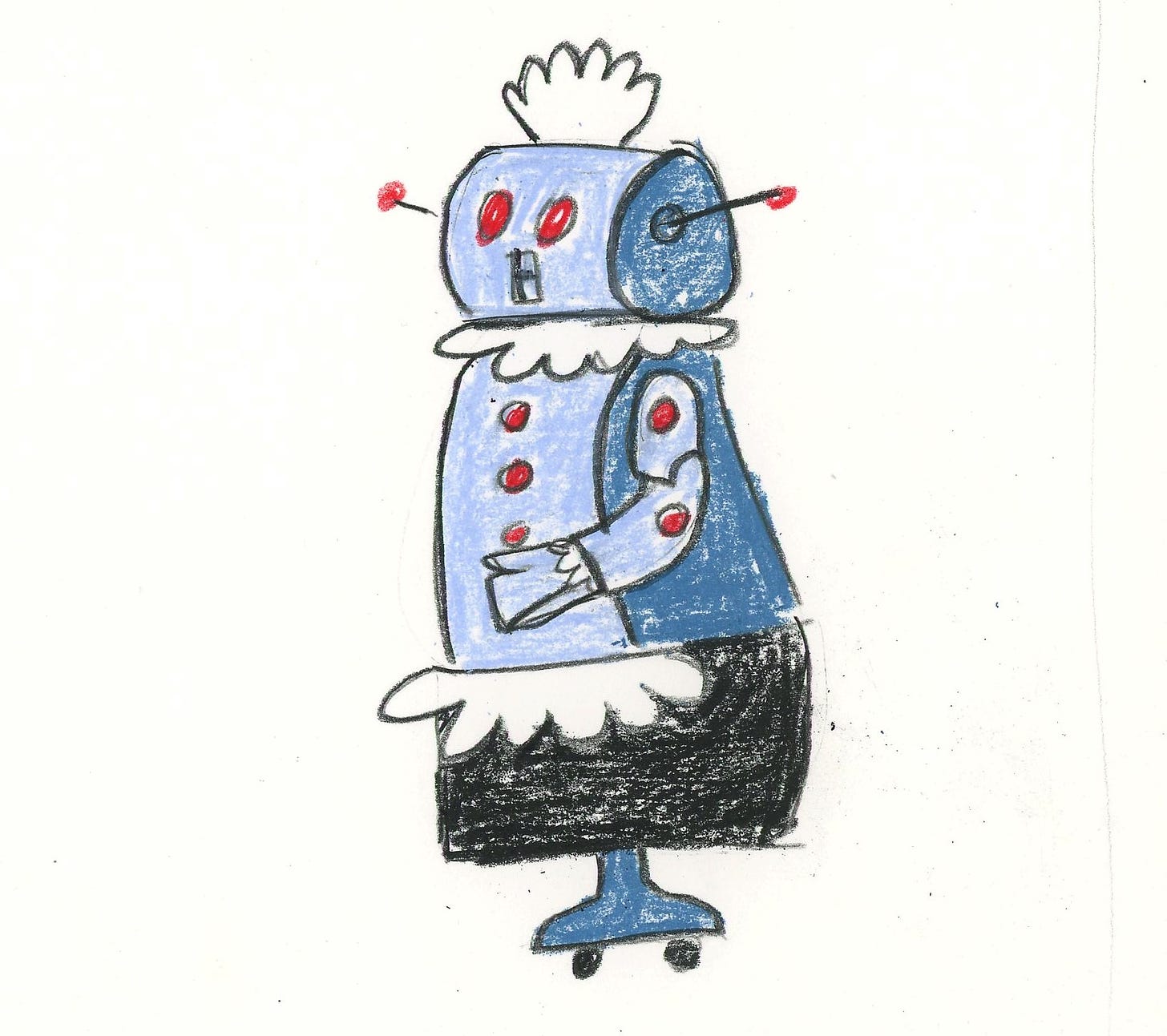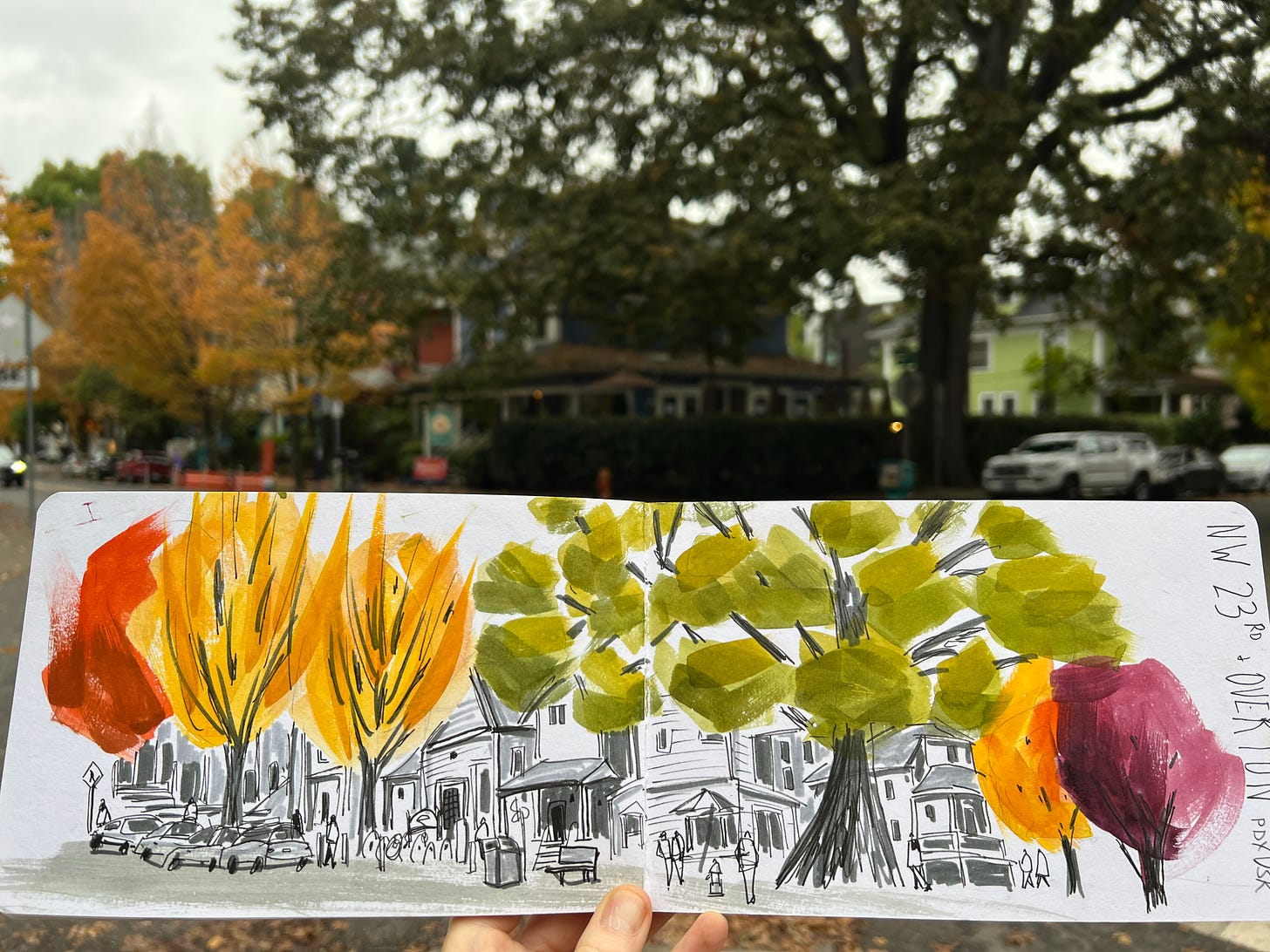Are you tired of hearing about AI?

AI! It’s everywhere, and already it’s so boring! How do I opt out of ever hearing about it again? Here are three delightful examples of people being people, doing things that only people can do, without any help or interference from robots.
Art Happens Here with John Lithgow
John Lithgow, who once studied art quite seriously and intended to be a painter, has made a PBS special in which he goes back to school and takes art classes. He joins a pottery class, a printmaking workshop, a dance class, and a music class. The kids good-naturedly help him along, even though I’m sure most of them had no idea who he was before he showed up with a camera crew. Everyone has a great time.
The idea behind the special was to highlight the importance of arts education in the schools, and it certainly does that, but what I really loved about it was watching this 78 year-old man apply himself seriously to these classes. He really works at the modern dance class, and he improves so much in the singing class that I was cheering for him by the end.
This is a show about the value of people making things together. I hope you get a chance to see it.
John Williams said some amazing things about music and filmmaking
I loved this interview on the Smartless podcast with legendary film composer John Williams. Over and over again, he reminded me of why we’re better off when real people come together to do real things. Fortunately, they put the podcast on YouTube, so I can queue up my favorite bits:
On the importance of seeing films in the theater, he said that we lose something by not seeing movies in theaters as a communal experience. “When we think of the music of Bach, three or four hundred years ago, there were no concert halls. If you wanted to hear music, you went to church…the concert hall is constructed to ring the antiquarian bells of our collective memory…and we go and watch Cary Grant and Audrey Hepburn in that atmosphere…that spiritual aspect of seeing films is largely gone.”
What a wonderful case to make for going out to a theater to experience film or plays or music with other people—that it rings the bells of our ancestral memories of gathering together to hear music when that was the only way it could be done.
Later on, he talked about the process of recording the score for the last fifteen minutes of ET. He describes this action-packed sequence and how hard it was for his orchestra, playing live, to hit every story beat in this complex series of events. “The orchestra wanted to bloom out, or blossom out, more than the film would allow me to do.” Spielberg suggested that he turn the film off so that the orchestra could play the music the way it needed to be played, and then he’d re-cut the ending to match the music.
Obviously, today a computer could make that music and it wouldn’t have any trouble syncing with the film. But Williams and Spielberg understood that the audience, at some level, would feel the effort of the musicians, and that some intangible quality would come out of the musicians allowing the music to bloom and breathe and be felt.
Beautiful.
One more:
Here he talks about Close Encounters, and tells the story of the iconic sequence of notes the spaceship played. He said something so surprising and interesting about those five notes: that last note, which he calls “so” in this clip: “So, in music, which is the fifth degree, is an equivalent in language to a conjunctive “but” or “and.”…What this does is…(he sings it and suggests that it sounds like the word) maybe?…It’s what you hear as a child, before language, and you know it’s not a complete sentence. There’s great power in that it doesn’t settle.” In other words, that last note is reaching out, asking for a response.
Will a robot ever understand that a musical note can sound like an unfinished thought? A request for more? Honestly, I hope not.
Jim Henson made everything by hand
I loved Ron Howard’s new documentary about Jim Henson. Looking back on Sesame Street and The Muppet Show, it’s astonishing to see how entirely handmade that entire production was. He made Kermit out of his mom’s old coat and cut a ping pong ball in half for the eyes. In the film, you see the physical effort it took to make those puppets do what they did.
Henson died in 1990, long before we were all carrying phones around in our pockets. I miss those days. I appreciate the craft and the physicality of what he did in a way that I didn’t when I was a kid, sitting in front of the TV.
Paid subscribers are painting trees
We’re into our second of four weeks on painting trees. Last week we looked at ways to mix a variety of greens, and this week we’re drawing tiny trees (the drawing’s tiny, the trees are big!)
For the price of a pencil or two, you get a weekly art lesson sent to your in-box, the occasional live Zoom, a pretty robust archive of lessons to dip into at your leisure, and you help keep the lights on around here. There’s also an option to join at a higher level and I’ll paint your vacation photo (or some photo), use that as a lesson for my subscribers, and mail you the finished painting. Notice that this “Patron of the Arts” level lets you choose the amount!
The Bit at the End
I’d love to see you on book tour! Many of these events ask that you pre-register.
Order a SIGNED copy of my new book, The Tree Collectors: Tales of Arboreal Obsession, from Broadway Books in Portland, OR.
Come find me on Instagram, or see paintings for sale- Right here
Order signed copies of some of my books from my husband’s bookstore, or order my books and many books I love at Bookshop.org
Take one of my online writing or art classes here





Great article in support of slow and real human art! I'm following you now on IG as emma_art_mm
Re: the "effort" of making music being audible to the audience
Years ago, I was at work listening to a Phillip Glass recording, which consisted of eight or so people playing similar, yet not identical musical phrases in sync with each other at high speed for ten minutes at a stretch. It's very difficult to play something like that while everyone around is playing a slight variation of it that only lines up with what you're playing once every 8 cycles (or whatever) while maintaining a count of where you are in the section and where you are in the piece. One of my workmates said "Oh, I can just do that with the 'arpeggiator' function on my keyboard (which allows you to just hold down all the keys in the sequence while the keyboard cycles through them in perfect time)--why do all that work?" I contended that the effort and slight inconsistencies of having people try to play the score perfectly where part of the beauty of the recording, but he was having none of it.
Not long afterwards he took a high paying position at noted guardian of artist rights, Spotify.
Re: Close Encounters of the Third Kind musical motif
The five notes correspond to the five syllable movie tagline "We Are Not Alone".
Re: Henson's handmade puppets
I saw an exhibit of them a few years ago, and they all look amazingly cheap in person. Old style TV hides a lot. Also, all the actual Frank Lloyd Wright pieces I've seen in person are really sloppy fit and finish but somehow photograph marvelously.